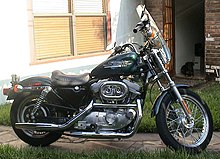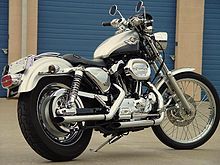Harley-Davidson Sportster
This article needs additional citations for verification. (December 2007) |
 | |
| Manufacturer | Harley-Davidson |
|---|---|
| Also called | "Sportie" |
| Production | since 1957 |
| Predecessor | Harley-Davidson KHK |
The Sportster is a line of motorcycles produced continuously since 1957 by the Harley-Davidson Motor Company. Sportster models are designated in Harley-Davidson's product code by beginning with "XL". In 1952, the predecessors to the Sportster, the Model K Sport and Sport Solo motorcycles, were introduced. These models K, KK, KH, and KHK of 1952 to 1956 are not always considered to be Sportsters, but are definitely the precursors and inspiration for the line.
Construction


Sportster motorcycles are powered by 45 degree V-twin engines in which both connecting rods, of the "fork and blade" or "knife & fork" design, share a common crank pin. The Sportster, the 45" R, D, G & W Models 1929-–3 side-valve motors, and the 'Big Twin' side-valve motors, which were: the flathead 74 cubic-inch (1213 cc) Models V , VL etc. (1930–1936), Models U and UL (1937–1948), and the 80 cubic-inch (1311 cc) Models VH and VLH (1935–1936), Models UH and ULH (1937–1941) have four separate cams, sporting one lobe per cam. The OHV 'Big Twins' used a single cam with four lobes until 1999 when the 'Twin Cam' appeared, with two cams and two lobes per cam.
Incidentally, the cam followers used in the Sportsters, K models, big twin side valve models, and the side-valve W Model series were a slightly shorter version of the followers used in the larger motors, but with the same Template:Auto in diameter body and Template:Auto in diameter roller follower since 1929. The company used similar cam followers for decades with minor changes, from the 1929 to the Eighties, probably the longest run for any engine part anywhere, in all Harley motors made those years one of these is called out.
Sportsters retained the K/KH design crankcase design, in which the transmission is contained in the same casting as the engine, and driven by the engine with a triple-row #35 chain primary drive and a multi-plate cable-operated clutch. Models since 1991 have five speeds; 1990 and earlier models had four speeds.
The engine was mounted directly to the frame from 1957 through the 2003 model year. While this system allows the bike to be somewhat lighter with more precise handling, it also transmits engine vibration directly to the rider. Sportsters released in 2004 and later use rubber isolation mounts and tie links to limit engine movement to a single plane, which greatly reduces vibration felt by the rider. Buell motorcycles built with variants of the Sportster engine have used a rubber mount system since 1987.
The Model K, from which the Sportster evolved, was the first civilian motorcycle produced by Harley-Davidson with hydraulic shock absorbers on both wheels. Common usage calls this a K Model.
The Sportster line of motorcycles has gone through three general stages, identified by the engine model used to power the motorcycles.
Model K series
This is developed from the earlier 45 W model, but with the revised engine and new 4-speed transmission contained in the same castings as would become the Sportster. The connecting rods would be inherited by the Sportster along with many other design features and dimensions.
- Model K and KK 1952–1953: 750 cc side-valve engines, using the 45 model bore and stroke
- Model KR (racing only) 1953–1969: 750 cc side-valve engines
- Model KH and KHK 1954–1956: 885 cc side-valve engines, using the 45 model bore, but with the stroke increased to 4.5625" (115.89 mm). This is the only small twin with a longer stroke than 3.8125", which is otherwise universal to the entire 45/K/Sportster line from 1929 to the present (exception: XR750, XB9 Buell).
X series Sportsters

- XL, Ironhead, 1957–1985: 900 cc and 1000 cc Ironhead overhead-valve engines with cast iron heads
- XR750 (racing only) 1970–1971: 750 cc overhead-valve engines, iron heads
- XR750 (racing only) 1972–1985: 750 cc overhead-valve engines, alloy heads
- XLCR Sportster (cafe racer)1977–1978: 1000 cc overhead-valve engines, iron heads
- XR1000 (racing only) 1983–1984: 1000 cc street model using XR racing cylinder head and other XR engine parts.
- XLR (racing only): 883 cc overhead-valve engines, iron heads
- XL, Evolution (also known as the "Evo"), since 1986: 883 cc, 1100 cc and 1200 cc Evolution overhead-valve engine, alloy heads
Significant changes by model year

- 1957 "Ironhead" overhead-valve engine introduced.
- 1972 "Ironhead" 1000 cc overhead-valve engine replaces 900 cc.
- 1975 Switched to left-side gear change (DOT mandate)
- 1979 Only year of the sportster that Harley produces with dual exhaust as opposed to staggered exhaust.
- 1985 Last year for the "Ironhead" overhead-valve engine.
- 1986 "Evolution" engine introduced in 883 cc and 1100 cc sizes.
- 1988 1200 cc engine replaces 1100 cc engine.
- 1988 Constant velocity carburetor replaces butterfly carburetor.
- 1991 Five-speed transmission replaces four-speed.
- 1991 Belt drive replaces chain drive on 883 Deluxe and all 1200 models.
- 1993 Belt drive made standard on all Sportsters.
- 1994 Improved oil tank, battery tray, and clutch made standard.
- 1994 New electrical system with sealed connectors
- 1998 XL1200S gets dual spark plug heads and high performance cams
- 2000 Introduced sealed wheel bearings and updated 4 piston brake calipers.
- 2004 All-new frame including rubber-mounted engine for decreased vibration. Elimination of the transmission trap door.
- 2005 Enlarged rear axle to 1" for increased stability.
- 2006 Helical cut transmission gears in all models reduces gear whine.
- 2006 New XR1200 is announced at the Intermot in Koln, Germany. The XR1200 is the first Harley-Davidson to utilize Down Draft DDFI II fuel injection. To be released as a late 2008 model.
- 2007 Fuel injection replaces carburetion on all models.
Production and notable Sportster models

- XLH is the standard model, with the "H" denoting high compression engine
- XLCH is considered difficult to start because of the combination of a Tillotson carburetor and magneto ignition.[1]
- XLX an entry level "Ironhead" era Sportster, available with sparce trim, in black only.
- XLS
- XLCR is the Cafe Racer model, available in 1979, and quite collectible today[2]
- XR1000
- XLH883 Hugger, with reduced seat height and reduced suspension, the precursor to the "XL low" models
- XL883C and XL1200C Custom – both these models have a 21 inch front laced and 16 inch solid disk rear wheels
- XL1200S Sport – this Sportster has adjustable suspension, dual disc front brakes, dual plug cylinder heads with single fire ignition, and hotter cams
- XL50 1200 50th Anniversary 2007 limited production of 2,000 models
Nightster
Introduced in 2007, the XL1200N Nightster includes unique features such as a chopped rear fender, denim paint scheme, front fork gaiters, and a side mount license plate. The riding position and Template:Auto in seat height of the Nightster are the same as those of the XL883L Sportster Low.
Knievel's XR-750
In 1970, Evel Knievel began using the XR-750 for his daredevil jumps. Although built to race, Knievel used the motorcycle and the Harley-Davidson sponsorship until 1977. The longest jump made by Knievel on the XR-750 was 133 ft (41 m) at Kings Island in 1975. In the 1980s, motorcycle jumping changed using motocross motorcycles, which were built to jump. However, daredevil Bubba Blackwell currently uses the XR-750 for jumping. Blackwell holds all jumping records on the XR-750, jumping 157 ft (48 m).
One of Knievel's signature red, white, and blue XR-750 motorcycles is currently housed at the Smithsonian American History Museum.[3]
XR1200
In the 2008 model year, Harley-Davidson released the XR1200 Sportster in Europe, Africa, and the Middle East. The XR1200 had an Evolution engine tuned to produce 91 bhp (68 kW), four-piston dual front disc brakes, and an aluminum swing arm. Motorcyclist featured the XR1200 on the cover of its July 2008 issue, and was generally positive about it in their "First Ride" story, in which Harley-Davidson was repeatedly asked to sell it in the United States.[4] One possible reason for the delayed availability in the United States was the fact that Harley-Davidson had to obtain the "XR1200" naming rights from Storz Performance, a Harley customizing shop in Ventura, Calif.[5] The XR1200 was released in the United States in 2009, in a special color scheme including Mirage Orange highlighting its dirt-tracker heritage. The first 750 XR1200 models in 2009 were pre-ordered and came with a number 1 tag for the front of the bike, autographed by Kenny Roberts and Scott Parker and a thank you/welcome letter from Harley-Davidson, signed by Bill Davidson.
Current models
Currently, the Sportster is offered in seven models. In 2009, the models are:
- 883 Low - XL 883L
- 883 Custom - XL 883C
- Iron 883 - XL 883 N
- 1200 Nightster - XL 1200N
- 1200 Low - XL 1200L
- 1200 Custom - XL 1200C
- XR1200
References
- ^ Phillip Tooth (January/February 2008). "1968 Harley-Davidson XLCH Sportster". Motorcycle Classics. Retrieved 2009-08-07.
{{cite web}}: Check date values in:|date=(help) - ^ Roland Brown (Premier Issue). "Harley-Davidson XLCR". Motorcycle Classics. Retrieved 2009-08-24.
{{cite web}}: Check date values in:|date=(help) - ^ http://americanhistory.si.edu/collections/object.cfm?key=35&objkey=175
- ^ Cathcart, Alan (2008). "First Ride: 2008 Harley-Davidson XR1200 - Get Sporty!". Motorcyclist. Source Interlink Magazines: 49–53.
{{cite journal}}: Cite has empty unknown parameters:|laydate=,|laysummary=,|laysource=, and|coauthors=(help); Unknown parameter|month=ignored (help) - ^ Richard Backus (September/October 2009). "2009 Harley-Davidson XR1200". Motorcycle Classics. Retrieved 2009-08-20.
{{cite web}}: Check date values in:|date=(help)
